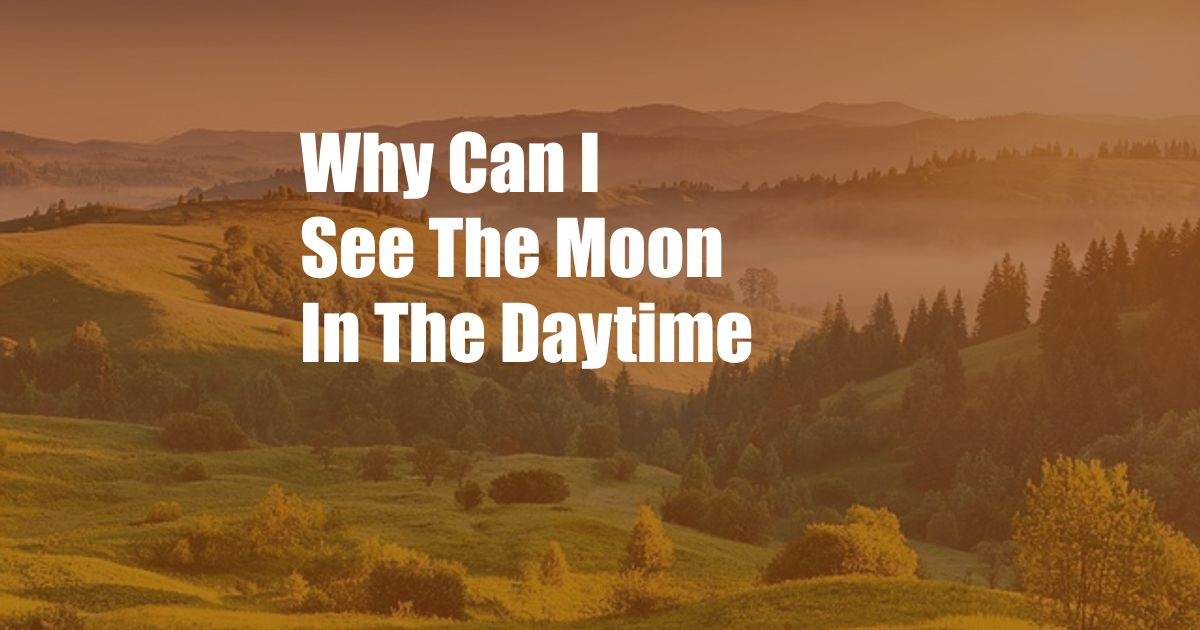
Why Can I See the Moon in the Daytime?
As a child, I remember gazing up at the sky during the day and being surprised to see the moon hanging there, a ghostly orb against the blue backdrop. I couldn’t understand why it was visible during the daytime, when it was supposed to be shining at night. Years later, I discovered the scientific reasons behind this celestial enigma.
As the Earth rotates on its axis, different parts of our planet face the sun at different times. When it’s daytime in one part of the world, it’s nighttime in another. However, the moon doesn’t revolve around the Earth in a perfect circle. Instead, its orbit is slightly elliptical, which means that sometimes it’s closer to the Earth and sometimes it’s farther away.
Moon’s Elliptical Orbit
When the moon is at its closest point to the Earth, it’s called perigee. At perigee, the moon appears slightly larger and brighter than usual. When the moon is at its farthest point from the Earth, it’s called apogee. At apogee, the moon appears slightly smaller and dimmer than usual.
The moon’s elliptical orbit also affects its apparent speed. When the moon is at perigee, it moves faster in its orbit. When the moon is at apogee, it moves slower in its orbit. This means that the moon’s phase changes more quickly when it’s at perigee and more slowly when it’s at apogee.
Daytime Moon Phases
The moon goes through a cycle of phases as it orbits the Earth. The new moon is when the moon is between the Earth and the sun, and its dark side is facing the Earth. The full moon is when the moon is on the opposite side of the Earth from the sun, and its light side is facing the Earth.
In between the new and full moons, the moon goes through a series of waxing and waning phases. The waxing moon is when the moon is getting bigger and brighter, and the waning moon is when the moon is getting smaller and dimmer. When the moon is in its waxing or waning phases, it can sometimes be seen during the daytime.
Factors Affecting Daytime Moon Visibility
There are a number of factors that can affect the visibility of the moon during the daytime. These factors include:
- The phase of the moon: The moon is most visible during the day when it’s in its waxing or waning gibbous phases.
- The time of day: The moon is most visible during the day when it’s high in the sky.
- The weather: The moon is most visible during the day when the sky is clear.
- The location of the observer: The moon is most visible during the day when the observer is in a high-altitude location.
Expert Tips for Daytime Moon Viewing
If you want to see the moon during the daytime, there are a few things you can do to improve your chances. First, check the moon’s phase and find out when it will be in its waxing or waning gibbous phases.
Second, plan to look for the moon during the early morning or late afternoon, when it’s high in the sky. Third, find a location with a clear view of the sky, and preferably at a high altitude. Finally, be patient and keep looking until you spot the moon.
FAQs
- Why can I see the moon in the daytime?
- The moon can be seen during the daytime because of its elliptical orbit around the Earth. When the moon is at its closest point to the Earth, it can be seen during the day even when it’s in its waxing or waning phases.
- What is the best time to see the moon in the daytime?
- The best time to see the moon in the daytime is during the early morning or late afternoon, when it’s high in the sky and the sky is clear. You may also be able to see the moon during the day if it’s in a waxing or waning gibbous phase.
- Where is the best place to see the moon in the daytime?
- The best place to see the moon in the daytime is in a location with a clear view of the sky, and preferably at a high altitude. Hilltops and mountains are good places to try.
Conclusion
The next time you see the moon hanging in the sky during the day, take a moment to appreciate its beauty and mystery. Remember that the moon is a celestial wonder that’s been inspiring humans for centuries. And if you’re lucky enough to see the moon in its waxing or waning gibbous phases, you’ll be treated to a truly unforgettable sight.
Are you interested in learning more about the moon? If so, check out some of the links below.